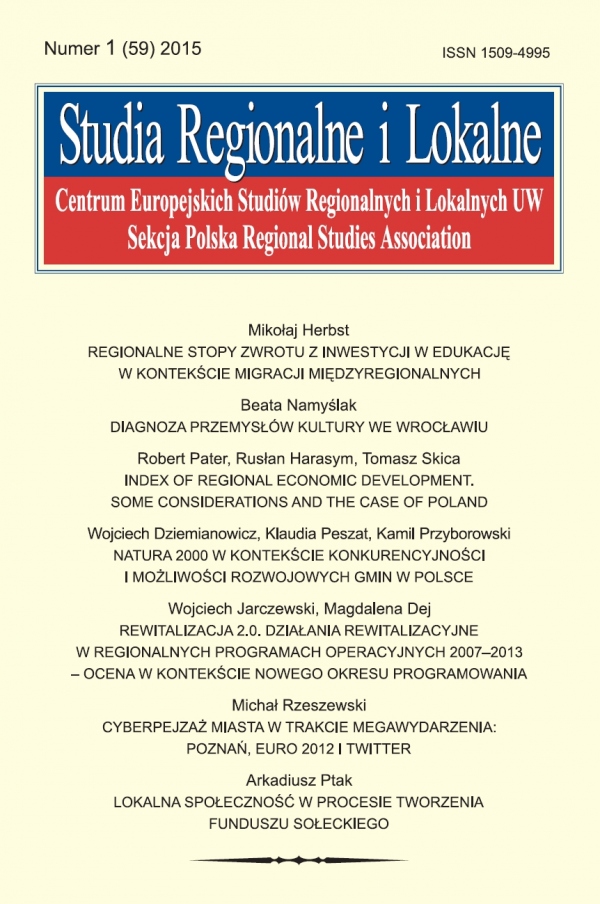Issue:
1(59)/2015
Robert Pater, Rusłan Harasym, Tomasz Skica
Index of regional economic development. Some considerations and the case of Poland
DOI: 10.7366/1509499515903
Wskaźnik rozwoju gospodarczego województw
W artykule zaproponowano miernik rozwoju społeczno-gospodarczego województw o postaci wskaźnika wielokomponentowego. Miernik obejmuje następujące obszary: technologia, infrastruktura, kapitał ludzki i kapitał społeczny, które definiowane są przez wiele innych wskaźników. Posiada on znaczące przewagi w stosunku do najczęściej stosowanego wskaźnika PKB per capita. Dane statystyczne, na podstawie których jest tworzony, są powszechnie dostępne i ze znacznie mniejszym opóźnieniem niż PKB na poziomie regionów. Wskaźnik ten pozwala ująć czynniki gospodarcze związane z długookresowym wzrostem gospodarczym, jak i efekty zewnętrzne, takie jak zmiany społeczne oraz zanieczyszczenie środowiska i inne. Zaproponowana konstrukcja wskaźnika obejmuje elementy wskaźników jakości życia, popularnych na poziomie krajów, jednak uwzględnia również czynniki niezbędne dla rozwoju gospodarek, a prowadzące do wzrostu wydajności pracy. Autorzy stoją na stanowisku, że takie ujęcie jest niezbędne w dobie problemów gospodarek z długookresowym wzrostem gospodarczym, wpływającym na ich rozwój. W artykule dokonano analizy empirycznej zaproponowanego miernika w odniesieniu do województw w latach 2009–2011. Stwierdzono podobieństwa, ale również wyraźne dywergencje wartości zaproponowanego wskaźnika w przekroju województw w stosunku do PKB per capita. Bazując na powyższych ustaleniach, dokonano także analizy przyczyn takiego stanu rzeczy.
Index of regional economic development. Some considerations and the case of Poland
A measure of economic development for regions is proposed in the form of a multicomponent index. This measure is composed of the following aspects: technology, infrastructure, human capital and social capital and defied by an array of indicators. Such a measure has significant advantages over the most commonly used indicator of GDP per capita. The statistical data based on which it is built are freely available and with a much shorter time lag than GDP at the regional level. This indicator makes it possible to depict economic factors behind long-run economic growth as well as to include less measurable factors such as social change, environmental degradation, etc. On the one hand, the proposed indicator comprises symptoms of the quality of life, and on the other hand, it includes factors which are essential for long-run economic growth and productivity. The authors show usefulness of such an indicator for policy formulation, which is rarely pointed out in the case of other indexes and is especially important at a time when long-run economic growth, and also development, in high-developed countries is endangered. The authors also discuss some general aspects of constructing indexes of economic development for regions, e.g., the often omitted problem of inclusion of cyclical indicators in the indexes of development. Empirical analysis of the proposed indicator is made for the NUTS-2 regions of Poland for the years 2009–2011.
Affiliation:
Robert Pater: University of Information Technology and Management, Chair of Macroeconomics, ul. Sucharskiego 2, 35-225 Rzeszow, Poland;
rpater@wsiz.rzeszow.pl Rusłan Harasym: University of Information Technology and Management, Chair of Macroeconomics, ul. Sucharskiego 2, 35-225 Rzeszow, Poland;
rharasym@wsiz.rzeszow.pl Tomasz Skica: University of Information Technology and Management, Chair of Finance, Institute for Financial Research and Analyses, ul. Sucharskiego 2, 35-225 Rzeszow, Poland;
tskica@wsiz.rzeszow.pl 


